
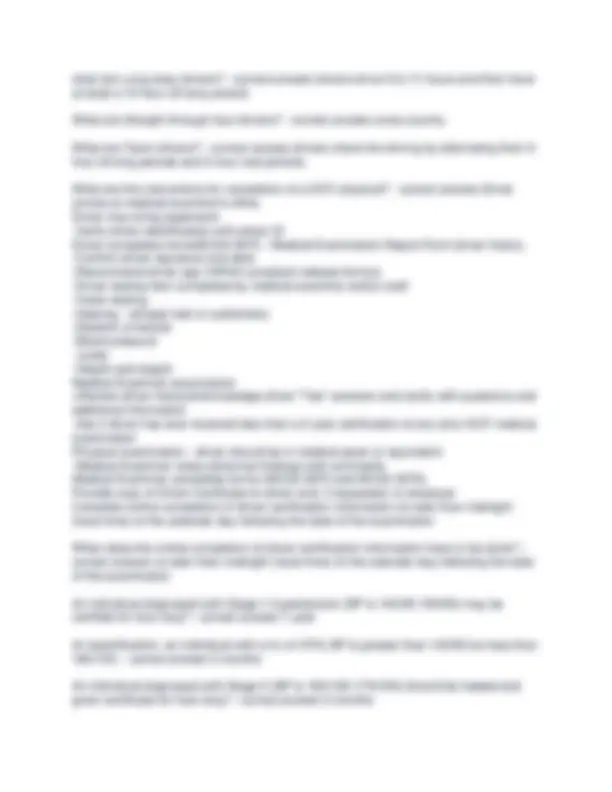
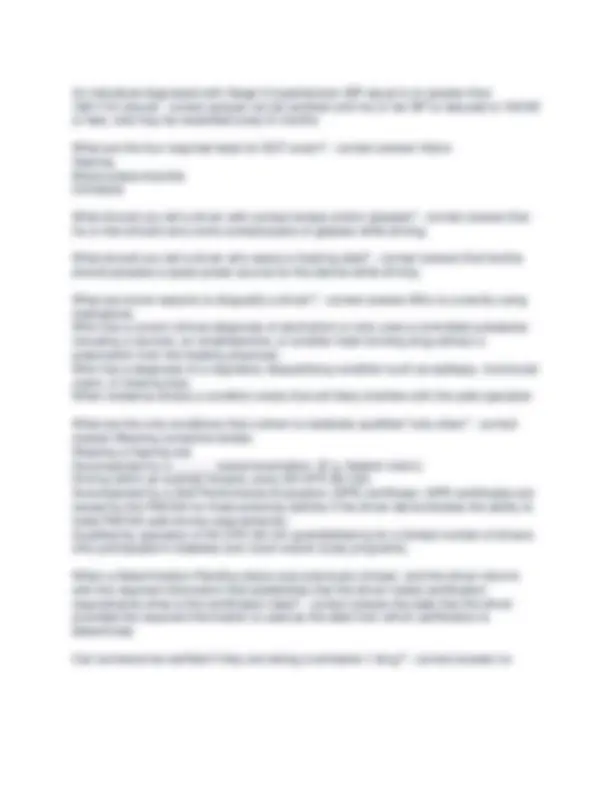
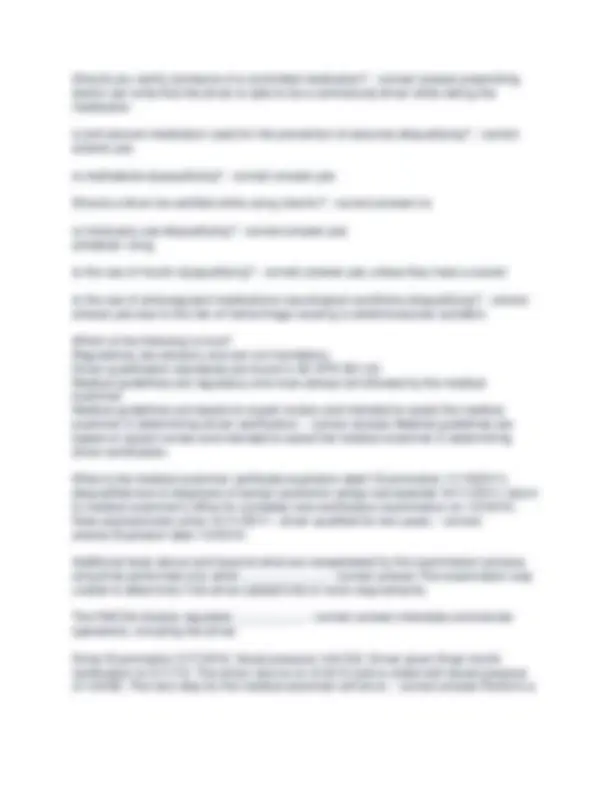
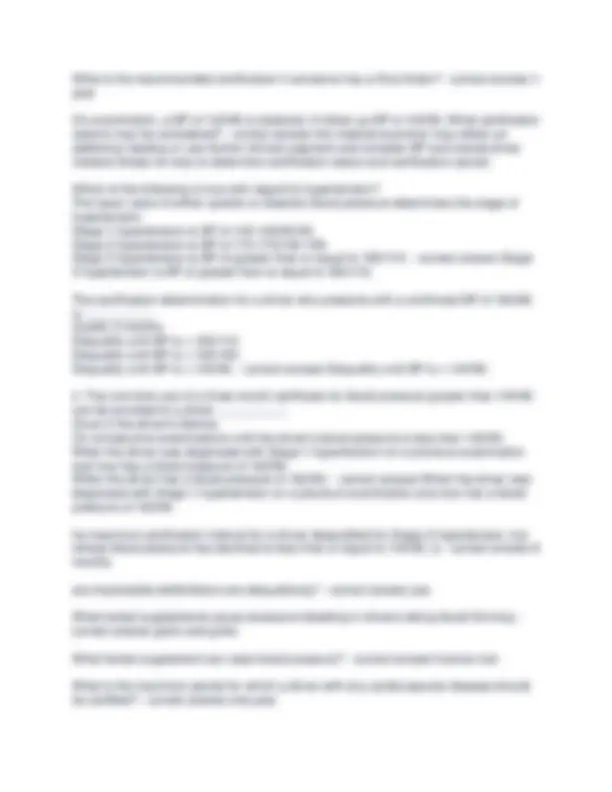
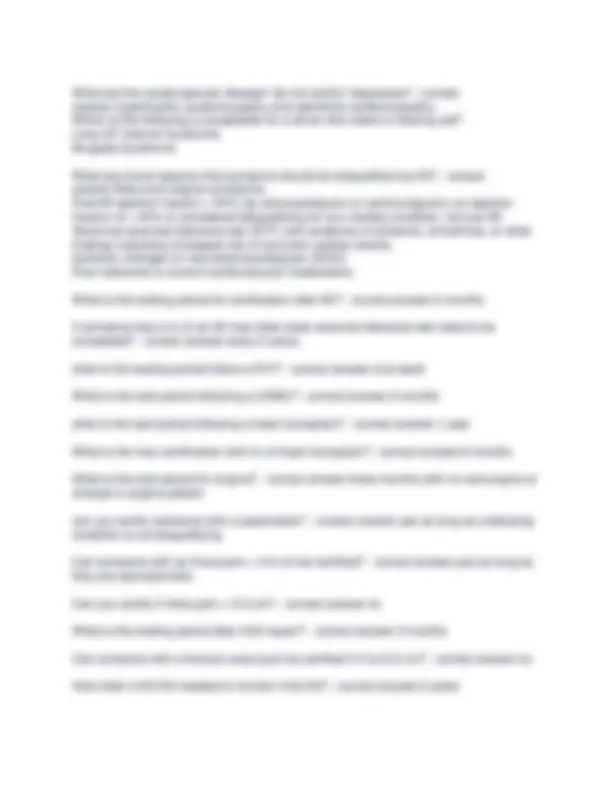
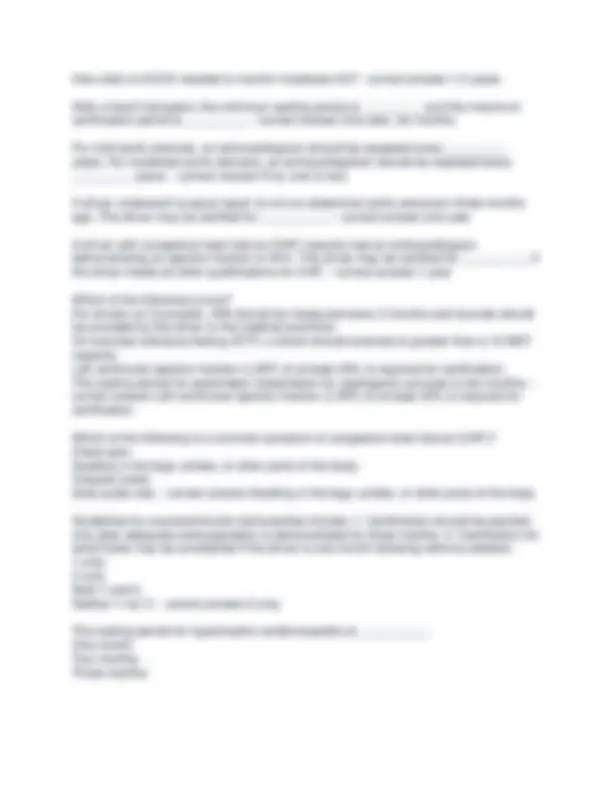
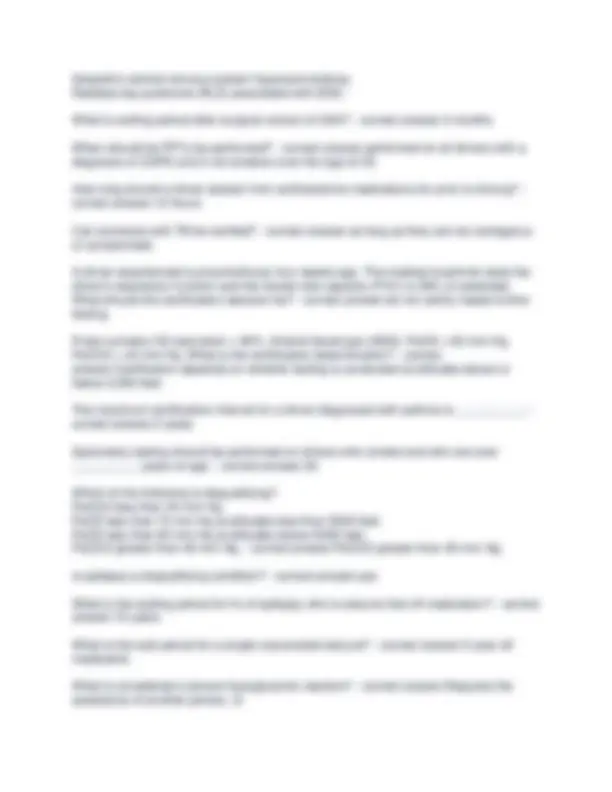
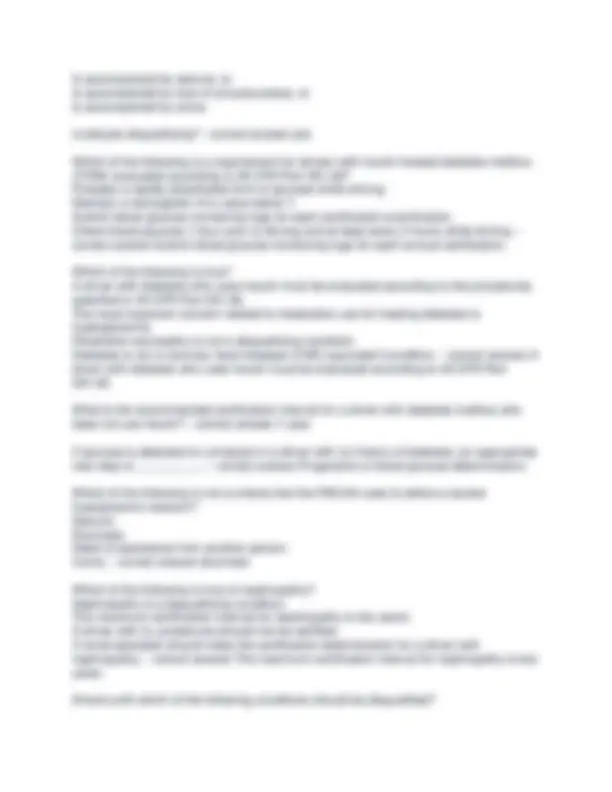
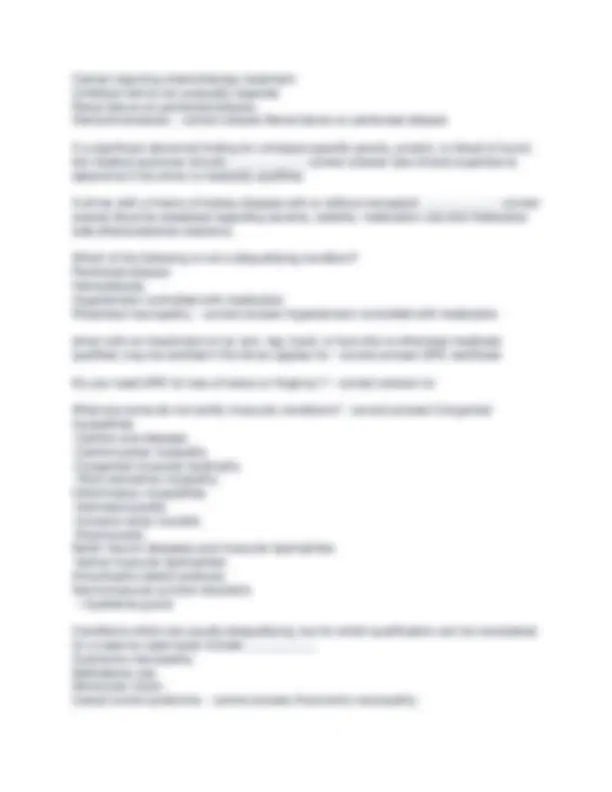
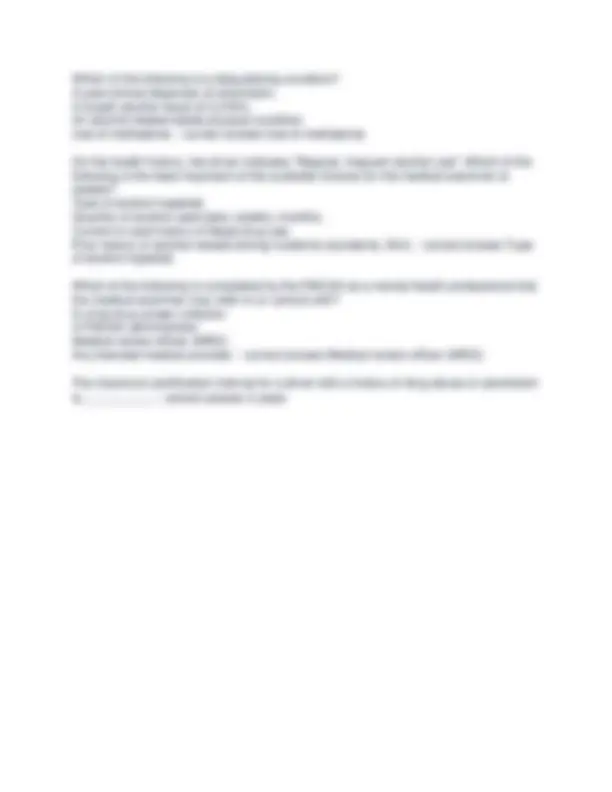


Study with the several resources on Docsity

Earn points by helping other students or get them with a premium plan


Prepare for your exams
Study with the several resources on Docsity

Earn points to download
Earn points by helping other students or get them with a premium plan
Community
Ask the community for help and clear up your study doubts
Discover the best universities in your country according to Docsity users
Free resources
Download our free guides on studying techniques, anxiety management strategies, and thesis advice from Docsity tutors
NRCME Exam With Latest Updated Solutions 2024.
Typology: Exams
1 / 18

This page cannot be seen from the preview
Don't miss anything!











What are regulations? - correct answer.Laws that must be followed What are disqualifying medical conditions? - correct answer.Epilepsy monocular vision hearing loss What are guidelines? - correct answer.Recommendation to follow but can have raptor ale for variation FMCSA medical program responsibilities include: Oversee the Department of Transportation. Regulation of intrastate commercial motor vehicle operations. Conduct and oversee the agency's medical exemption and certificate programs. Provide commercial motor vehicle driver examinations. - correct answer.Conduct and oversee the agency's medical exemption and certificate programs. Which of the following is true? The FMCSA does not consider feasibility or impact in the rule-making process. Only the Medical Review Board can provide advice and opinions on FMCSA rulemaking. FMCSA medical standards and guidelines are subject to public notice and comment rulemaking. The Code of Federal Regulations provide guidance that the medical examiner may or may not follow.examiner may or may not follow. - correct answer.FMCSA medical standards and guidelines are subject to public notice and comment rulemaking. FMCSA content sources rules and regulations include 49 CFR Part 16 DOT Procedures for Drug and Alcohol Testing. 49 CFR 391.41 Physical Qualifications for Drivers. 49 CFR 391.82 Medical examination; certificate of physical qualification. 49 CFR Part 73: Medical Review Board procedures. - correct answer.49 CFR 391. Physical Qualifications for Drivers. Which of the following is true regarding why regulation is needed to protect public safety?
There is little environmental risk from crashes involving hazardous materials. There is greater risk of injury and fatalities to individuals in smaller vehicles from crashes involving commercial motor vehicles. The economic cost of crashes involving commercial vehicles is relatively low. Commercial vehicles do not carry members of the public. - correct answer.There is greater risk of injury and fatalities to individuals in smaller vehicles from crashes involving commercial motor vehicles. Which of the following is true? By May 21, 2015, medical providers that perform medical examinations for commercial motor vehicle drivers must have completed an approved training program and passed a national certification examination. The Medical Examiner may request that an appropriate specialist provider make the driver certification determination. The purpose of the commercial motor vehicle driver examination is for treatment of driver medical conditions. FMCSA guidance recommendations may or may not be followed by the Medical Examiner. - correct answer.FMCSA guidance recommendations may or may not be followed by the Medical Examiner.` What is the role of the medical examiner? - correct answer.to determine medical fitness for duty. What are the differences between the medical standards and the medical guidelines - correct answer.Medical Standards - regulations that are non-discretionary - the medical examiner cannot use judgment to certify a driver who does not meet a regulatory standard Medical Guidelines are discretionary - Medical Examiners may decide to certify drivers who do not meet medical guidelines. Most recommendations related to certification of specific medical conditions are guidance What are some medical standards for certifications that need to be done? - correct answer.Vision requirements, including distant visual acuity, horizontal vision, and color vision. Drivers who do not meet standards cannot be certified unless accompanied by a vision exemption/waiver. Diabetes requirements: drivers using insulin cannot be certified unless special procedures for evaluation and certification of such drivers are followed. Epilepsy: drivers with a diagnosis of epilepsy cannot be certified unless accompanied by an epilepsy waiver/exemption. Hearing: drivers who cannot meet whisper test or audiometric test requirements cannot be certified unless accompanied by a hearing waiver/exemption. What are Turn around or short relay drivers? - correct answer.drivers return to their home base each evening
An individual diagnosed with Stage 3 hypertension (BP equal to or greater than 180/110) should - correct answer.not be certified until his or her BP is reduced to 140/ or less, and may be recertified every 6 months What are the four required tests for DOT exam? - correct answer.Vision Hearing Blood pressure/pulse Urinalysis What should you tell a driver with contact lenses and/or glasses? - correct answer.that he or she should carry extra contacts/pairs of glasses while driving. What should you tell a driver who wears a hearing aide? - correct answer.that he/she should possess a spare power source for the device while driving. What are some reasons to disqualify a driver? - correct answer.Who is currently using methadone. Who has a current clinical diagnosis of alcoholism or who uses a controlled substance including a narcotic, an amphetamine, or another habit-forming drug without a prescription from the treating physician. Who has a diagnosis of a regulatory disqualifying condition such as epilepsy, monocular vision, or hearing loss. When evidence shows a condition exists that will likely interfere with the safe operation What are the only conditions that a driver is medically qualified "only when" - correct answer.Wearing corrective lenses Wearing a hearing aid. Accompanied by a ______ waiver/exemption. (E.g. federal vision). Driving within an exempt intracity zone (49 CFR 391.62). Accompanied by a Skill Performance Evaluation (SPE) certificate. (SPE certificates are issued by the FMCSA for fixed extremity deficits if the driver demonstrates the ability to meet FMCSA safe driving requirements). Qualified by operation of 49 CFR 391.64 (grandfathering for a limited number of drivers who participated in diabetes and vision waiver study programs). When a Determination Pending status was previously chosen, and the driver returns with the required information that establishes that the driver meets certification requirements what is the certification date? - correct answer.the date that the driver provided the required information is used as the date from which certification is determined. Can someone be certified if they are taking a schedule 1 drug? - correct answer.no
Should you certify someone of a controlled medication? - correct answer.prescribing doctor can write that the driver is safe to be a commercial driver while taking the medication is anti-seizure medication used for the prevention of seizures disqualifying? - correct answer.yes is methadone dysqualifying? - correct answer.yes Should a driver be certified while using chantix? - correct answer.no is marijuana use disqualifying? - correct answer.yes schedule I drug Is the use of insulin dysqualifying? - correct answer.yes unless they have a wavier Is the use of anticoagulant medications neurological conditions disqualifying? - correct answer.yes due to the risk of hemorrhage causing a cerebrovascular accident. Which of the following is true? Regulations are advisory and are not mandatory. Driver qualification standards are found in 49 CFR 391.43. Medical guidelines are regulatory and must always be followed by the medical examiner. Medical guidelines are based on expert review and intended to assist the medical examiner in determining driver certification. - correct answer.Medical guidelines are based on expert review and intended to assist the medical examiner in determining driver certification. What is the medical examiner certificate expiration date? Examination 11/16/2011; disqualified due to diagnosis of benign positional vertigo last episode 10/11/2011; return to medical examiner's office for complete new certification examination on 1/2/2012. Note asymptomatic since 10/11/2011 - driver qualified for two years. - correct answer.Expiration date 1/2/2014. Additional tests above and beyond what are necessitated by the examination process should be performed only when ____________. - correct answer.The examination was unable to determine if the driver passed one or more requirements. The FMCSA directly regulates __________. - correct answer.Interstate commercial operations, including the driver. Driver Examination 2/17/2012, blood pressure 144/102. Driver given three month certification to 5/17/12. The driver returns on 3/16/12 and is noted with blood pressure of 124/82. The next step for the medical examiner will be to: - correct answer.Perform a
Issuing the prescription for the driver's contact lenses and/or glasses. Providing the driver with contact information for the Federal Vision Exemption Program. Assuring that the driver has peripheral vision of at least 110 degrees in each eye. - correct answer.Providing the driver with contact information for the Federal Vision Exemption Program. What eye conditions must the medical examiner ask the driver about? - correct answer.Retinopathy, cataracts, aphakia, glaucoma, macular degeneration A driver who wears contact lenses which correct farsightedness in one eye and nearsightedness in the other, but has no other visual impairments can be certified under what additional conditions - correct answer.FMCSA guidance indicates that a driver should not be certified under these circumstances. Which of the following drivers' tests meet hearing certification standards? Whisper test 4 feet right ear, 3 feet left ear. Whisper test 5 feet right ear with hearing aid, 3 feet left ear without hearing aid. Audiogram left 30/500 Hz, 40/1000 Hz, 60/2000 Hz; right 25/500 Hz, 35/1000 Hz, 80/2000 Hz. Audiogram left 35/500 Hz, 50/1000 Hz, 40/3000 Hz; right 35/500 Hz, 35/1000 Hz, 60/3000 Hz. - correct answer.Whisper test 5 feet right ear with hearing aid, 3 feet left ear without hearing aid. An audiometric test produces the following results: Left ear: 500 Hz, 35dB Loss; 1, Hz, 35 dB loss; 2,000 Hz 45 dB loss. Right ear: 500 Hz, 40 dB loss; 1,000 Hz, 45 dB loss; 2,000 40 dB loss. What is the certification? - correct answer.2 years A driver has loss of hearing in the better ear of 25 dB loss at 500 Hz, 40 dB loss at 1000 Hz, and 60 dB loss at 2000 Hz. With respect to the hearing requirement for medical certification, the driver __________. - correct answer.do not certify What BP readings are considered stage I HTN? - correct answer.140-159/90- 99 What BP readings are considered stage II HTN? - correct answer.160-179/100- 109 Is stage II HTN an indication for anti-hypertensive drug therapy? - correct answer.yes What BP readings are considered stage III HTN? - correct answer.BP > 180/ If the drivers BP is > 180/110? - correct answer.they are disqualified a driver with a history of Stage 3 hypertension may only be certified for... - correct answer.6 months how often do you need to monitor INR on coumadin therapy? - correct answer.monthly
What is the recommended certification if someone has a-fib/a-flutter? - correct answer. year On examination, a BP of 140/90 is obtained. A follow-up BP is 140/90. What certification options may be considered? - correct answer.the medical examiner may obtain an additional reading or use his/her clinical judgment and consider BP and overall driver medical fitness for duty to determine certification status and certification period. Which of the following is true with regard to hypertension? The lower value of either systolic or diastolic blood pressure determines the stage of hypertension. Stage 1 hypertension is BP of 140-149/90-99. Stage 2 hypertension is BP of 170-179/100-109. Stage 3 hypertension is BP of greater than or equal to 180/110. - correct answer.Stage 3 hypertension is BP of greater than or equal to 180/110. The certification determination for a driver who presents with a confirmed BP of 182/ is __________. Qualify 3 months. Disqualify until BP is < 180/110. Disqualify until BP is < 160/100. Disqualify until BP is < 140/90. - correct answer.Disqualify until BP is < 140/90.
How often is ECHO needed to monitor moderate AS? - correct answer.1-2 years After a heart transplant, the minimum waiting period is _________ and the maximum certification period is _________. - correct answer.One year, six months. For mild aortic stenosis, an echocardiogram should be repeated every _________ years. For moderate aortic stenosis, an echocardogdram should be repeated every _________ years. - correct answer.Five, one to two. A driver underwent surgical repair of a 6 cm abdominal aortic aneurysm three months ago. The driver may be certified for __________. - correct answer.one year A driver with congestive heart failure (CHF) recently had an echocardiogram demonstrating an ejection fraction of 44%. The driver may be certified for __________ if the driver meets all other qualifications for CHF. - correct answer.1 year Which of the following is true? For drivers on Coumadin, INR should be measured every 3 months and records should be provided by the driver to the medical examiner. On exercise tolerance testing (ETT), a driver should exercise to greater than a 10 MET capacity. Left ventricular ejection fraction (LVEF) of at least 40% is required for certification. The waiting period for pacemaker implantation for cardiogenic syncope is two months. - correct answer.Left ventricular ejection fraction (LVEF) of at least 40% is required for certification. Which of the following is a common symptom of congestive heart failure (CHF)? Chest pain. Swelling in the legs, ankles, or other parts of the body. Irregular pulse. Slow pulse rate. - correct answer.Swelling in the legs, ankles, or other parts of the body Guidelines for supraventricular tachycardias include: 1. Certification should be granted only after adequate anticoagulation is demonstrated for three months. 2. Certification for atrial flutter may be considered if the driver is one month following isthmus ablation. 1 only. 2 only. Both 1 and 2. Neither 1 nor 2. - correct answer.2 only. The waiting period for hypertrophic cardiomyopathy is __________. One month. Two months. Three months.
There is no waiting period. Hypertrophic cardiomyopathy is a disqualifying condition. - correct answer.There is no waiting period. Hypertrophic cardiomyopathy is a disqualifying condition. what is the waiting period following cerebellum or brainstem vascular lesions strokes? - correct answer.1 year; not at risk for seizure what is the waiting period following cortical or subcortical deficits from a stroke? - correct answer.5 years increased risk of seizures is dementia disqualifying? - correct answer.yes what is min waiting period seizure-free and off anticonvulsant medication following moderate TBI without early seizures or mild TBI with early seizures.? - correct answer. years what is the min waiting period seizure free and off anticonvulsant medication following moderate TBI with early seizures. - correct answer.5 years what is the min wait period following surgical removal of Infratentorial meningioma, acoustic neuromas, pituitary adenomas, spinal benign tumors, benign extra-axial tumors? - correct answer.1 year what is the min waiting period after surgical removal of Benign supratentorial tumors, spinal tumors? - correct answer.2 years What is the wait period seizure free and off anticonvulsant medication following bacterial meningitis without early seizures or viral encephalitis without early seizures? - correct answer.1 year What is the waiting period seizure free and off anticonvulsant medication following bacterial meningitis with early seizures.? - correct answer.5 years What is the waiting period seizure free and off anticonvulsant medication following viral encephalitis with early seizures? - correct answer.10 years A driver with a history of bacterial meningitis with early seizures or a single unprovoked seizure requires a waiting period of __________ seizure free and off anticonvulsant medications. - correct answer.5 years Transient ischemic attacks (TIA's) are automatically disqualifying for __________. After the minimum waiting period the certification depends on the interval history, general health, neurological examination, and compliance with the treatment program. - correct answer.1 year
Idiopathic central nervous system hypersomnolence. Restless leg syndrome (RLS) associated with EDS.` What is waiting period after surgical correct of OSA? - correct answer.3 months When should be PFTs be performed? - correct answer.performed on all drivers with a diagnosis of COPD and in all smokers over the age of 35. How long should a driver abstain from antihistamine medications for prior to driving? - correct answer.12 hours Can someone with TB be certifed? - correct answer.as long as they are not contagious or symptomatic A driver experienced a pneumothorax four weeks ago. The medical examiner tests the driver's respiratory function and the forced vital capacity (FVC) is 58% of predicted. What should the certification decision be? - correct answer.do not certify-needs further testing Pulse oximetry O2 saturation = 90%. Arterial blood gas (ABG): PaO2 = 60 mm Hg, PaCO2 = 42 mm Hg. What is the certification determination? - correct answer.Certification depends on whether testing is conducted at altitudes above or below 5,000 feet. The maximum certification interval for a driver diagnosed with asthma is __________. - correct answer.2 years Spirometry testing should be performed on drivers who smoke and who are over __________ years of age. - correct answer. Which of the following is disqualifying? PaCO2 less than 45 mm Hg. PaO2 less than 70 mm Hg at altitudes less than 5000 feet. PaO2 less than 65 mm Hg at altitudes above 5000 feet. PaCO2 greater than 45 mm Hg. - correct answer.PaCO2 greater than 45 mm Hg. is epilepsy a disqualifying condition? - correct answer.yes What is the waiting period for hx of epilepsy who is seizure free off medication? - correct answer.10 years What is the wait period for a single unprovoked seizure? - correct answer.5 year off medication What is considered a severe hypoglycemic reaction? - correct answer.Requires the assistance of another person, or
Is accompanied by seizure, or Is accompanied by loss of consciousness, or Is accompanied by coma. is dialysis disqualifying? - correct answer.yes Which of the following is a requirement for drivers with insulin-treated diabetes mellitus (ITDM) evaluated according to 49 CFR Part 391.46? Possess a rapidly absorbable form of glucose while driving. Maintain a hemoglobin A1c value below 7. Submit blood glucose monitoring logs for each certification examination. Check blood glucose 1 hour prior to driving and at least every 2 hours while driving. - correct answer.Submit blood glucose monitoring logs for each annual certification. Which of the following is true? A driver with diabetes who uses insulin must be evaluated according to the procedures specified in 49 CFR Part 391.46. The most important concern related to medication use for treating diabetes is hyperglycemia. Peripheral neuropathy is not a disqualifying condition. Diabetes is not a coronary heart disease (CHD) equivalent condition. - correct answer.A driver with diabetes who uses insulin must be evaluated according to 49 CFR Part 391.46. What is the recommended certification interval for a driver with diabetes mellitus who does not use insulin? - correct answer.1 year If glucose is detected on urinalysis in a driver with no history of diabetes, an appropriate next step is __________. - correct answer.Fingerstick or blood glucose determination. Which of the following is not a criteria that the FMCSA uses to define a severe hypoglycemic reaction? Seizure. Dizziness. Need of assistance from another person. Coma. - correct answer.dizziness Which of the following is true of nephropathy? Nephropathy is a disqualifying condition. The maximum certification interval for nephropathy is two years. A driver with 3+ proteinuria should not be certified. A renal specialist should make the certification determination for a driver with nephropathy. - correct answer.The maximum certification interval for nephropathy is two years. Drivers with which of the following conditions should be disqualified?
A Skill Performance Evaluation (SPE) certificate pursuant to 49 CFR 391.49 is granted under which of the following conditions? The driver has a fixed deficit of the torso. The driver has progressive deficit of an extremity. The driver has a medical evaluation summary completed by a board qualified or certified physiatrist or orthopedic surgeon. The driver has completed a driving evaluation per FMCSA standards. - correct answer.The driver has a medical evaluation summary completed by a board qualified or certified physiatrist or orthopedic surgeon. Examples of adapting clinical evaluation of the musculoskeletal system include which of the following? Using resistive force or a dynamometer to the have the driver demonstrate grip strength necessary to grasp a steering wheel. Nerve conduction study testing. Two point discrimination testing. Audiometric testing. - correct answer.Using resistive force or a dynamometer to the have the driver demonstrate grip strength necessary to grasp a steering wheel. The maximum certification interval for a driver with a Skill Performance Evaluation (SPE) certificate is __________. - correct answer.2 years What is the min waiting period symptom free following nonpsychotic major depression unaccompanied by suicidal behavior.? - correct answer.6 months What is the waiting period following a severe depressive episode, a suicide attempt, or a manic episode? - correct answer.1 year What is the max certification for adult ADHD treated with a stimulant? - correct answer. year should someone with dx schizophrenia be disqualifed? - correct answer.yes Which of the following is true with respect to drivers with psychological disorders? Drivers with chronic schizophrenia must be evaluated at least yearly by a qualified specialist such as a psychiatrist or psychologist who understands the function and demands of CMV driving. The waiting period for a brief reactive psychosis or schizophreniform disorder is three months. Alcohol and drug dependency and abuse are profound risk factors in the presence of personality disorders. The waiting period following electroconvulsive therapy for treatment of depression is one year. - correct answer.Alcohol and drug dependency and abuse are profound risk factors in the presence of personality disorders.
Which of the following is true with respect to bipolar disorder? Treatment with lithium has not been shown to increase risk for CMV accidents. The maximum certification interval is six months. The driver should be advised to report manic or severe depressive episodes within 10 days of onset to the driver's employer, medical examiner, or appropriate health professional and to seek medical intervention. Onset of manic episodes is uniformly sudden. - correct answer.Treatment with lithium has not been shown to increase risk for CMV accidents. Which of the following is not associated with safety risks in drivers with psychological disorders? The mental disorder, including symptoms and/or disturbances in performance that are an integral part of the disorder and may pose hazards for driving. Residual symptoms occurring after time-limited reversible episodes or initial presentation of the full syndrome that can interfere with safe CMV driving. Physical disorders which may be compromised by the mental disorder and may increase risk of CMV accidents. Psychopharmacology, as many psychotropic medications can compromise performance to the degree that CMV driving would be hazardous. - correct answer.Physical disorders which may be compromised by the mental disorder and may increase risk of CMV accidents.